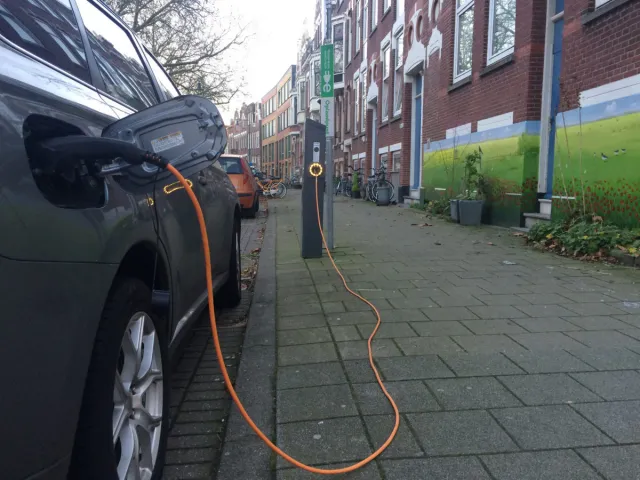Economics of road transport starting to favor renewables
Aug 6, 2019 05:36 PM ET
- According to a new report by BNP Paribas Asset Management, renewables offer more advantages than simply mitigating climate change. Electricity is easier to transport than oil, and wind and solar electricity prices are much more stable than volatile oil prices. An analyst from the French bank argues that major producers will need to reduce oil prices below $20 to compete with clean energy in the transport sector.

The oil industry will probably fail in its fight for supremacy against solar and wind in the transport sector, according to “The Death Toll for Petrol – Eroci and the End of the Petroleum Age,” a new report by France’s BNP Paribas Asset Management.
Mark Lewis, the author of the report and the global head of sustainability research at the French financial services provider, introduces the concept of Energy Return on Capital Invested (EROCI). This new metric — a variation on vehicle miles travelled (VMT), or vehicle kilometres travelled (VKT) — is based on a hypothetical $100 billion investment in oil and renewables, primarily to power cars and other light-duty vehicles.
“For a given capital outlay on oil and renewables, how much useful energy at the wheels do we get? Our analysis indicates that for the same capital outlay today, new wind and solar-energy projects in tandem with battery electric vehicles (EVs) will produce 6x-7x more useful energy at the wheels than will oil at $60/bbl for gasoline-powered LDVs, and 3x-4x more than will oil at $60/bbl for LDVs running on diesel,” Lewis writes.
No match for solar and wind
Assuming a cost of $60/MWh for onshore wind, $70/MWh for offshore wind, and $65/MWh for solar-PV — as well as the aforementioned $100 billion outlay — the analyst says the three technologies would be able to generate 1,881 TWh, 1,673 TWh, and 1,667 TW over 25 years, respectively. That compares with just 270 TWh produced for gasoline-powered vehicles, with crude oil purchased on the spot market today. “For diesel-powered engines, the numbers are only marginally better than those for gasoline,” Lewis states.
Lewis stresses that there are other advantages in prioritizing solar and wind, such as the positive implications for air pollution and climate change, as well as public health benefits. Furthermore, renewable energy prices are much more stable than those of volatile fossil fuels, and clean power is much easier to transport.
Incumbent advantage
Oil nonetheless maintains a “massive incumbent advantage” over clean energy in the transport sector. Last year it still had a 33% share of the global energy mix, while renewables only accounted for 3%. Its infrastructural advantage, according to the report, also depends on the ability of the oil industry to provide large, instantaneous flows of energy on the spot market, while wind and solar deliver power over a 25-year lifecycle.
“This underlines the point that the renewable-energy industry needs to scale up massively over the coming decades, since on an absolute unadjusted basis wind and solar cannot deliver anything close to the energy that the global oil industry can deliver today as an instantaneous flow,” Lewis says.
However, the incumbent advantages of oil are limited, as uncertainty about new investments is spreading in the oil sector, even though new projects are needed every year to replace lost production.
“Of course, there remain big infrastructure challenges to be overcome — and paid for — if the potential of renewables in tandem with EVs is to be fulfilled over the next two decades,” the report notes. “But as the net-energy yield over the full life-cycle of renewables versus oil will only continue to improve over the next decade the competitive advantage is set to shift decisively in favour of EVs over oil-powered cars in the next five years.”
Mission impossible?
Given this scenario — which also sees electric vehicles reaching cost parity with conventional light vehicles by 2024 — oil will have to be traded at much lower prices over the long term to remain competitive in the mobility market.
“For the oil majors, the challenge is on a scale that they have never faced before,” Lewis states. “And business-as-usual is simply not an option.”
New oil projects with break-even costs of $20/bbl are at particularly high risk of becoming stranded over the long term, Lewis adds. “It is only a matter of time before the economics of renewables and EVs overwhelm oil and displace up to 40% of its current demand,” he writes.
From his EROCI analysis, Lewis found that, in order to remain competitive, oil would have to be traded at between $9/bbl and $10/bbl to provide energy for LDVs running on gasoline and at between $17/bbl and $19/bbl for diesel-fuelled LDVs, as new wind and new solar projects will generate electricity for EVs over an assumed operating life of 25 years.
“In short, whether in the form of gasoline or diesel, oil’s days as a fuel for LDVs are clearly numbered because our EROCI analysis shows that the economics of new wind and solar projects combined with EVs are set to become irresistible,” Lewis concludes.
Also read
- Altus Power Buys 234 MW U.S. Solar-Storage Portfolio
- Molecular Tuning Lifts Perovskite-Silicon Tandems to 32.3%
- Soltage raises $80m debt to expand U.S. solar and storage pipeline
- Voltalia prepares site for 43-MW solar-storage hybrid in French Guiana
- Poland funds eight energy clusters, thousands of rooftop solar installs

